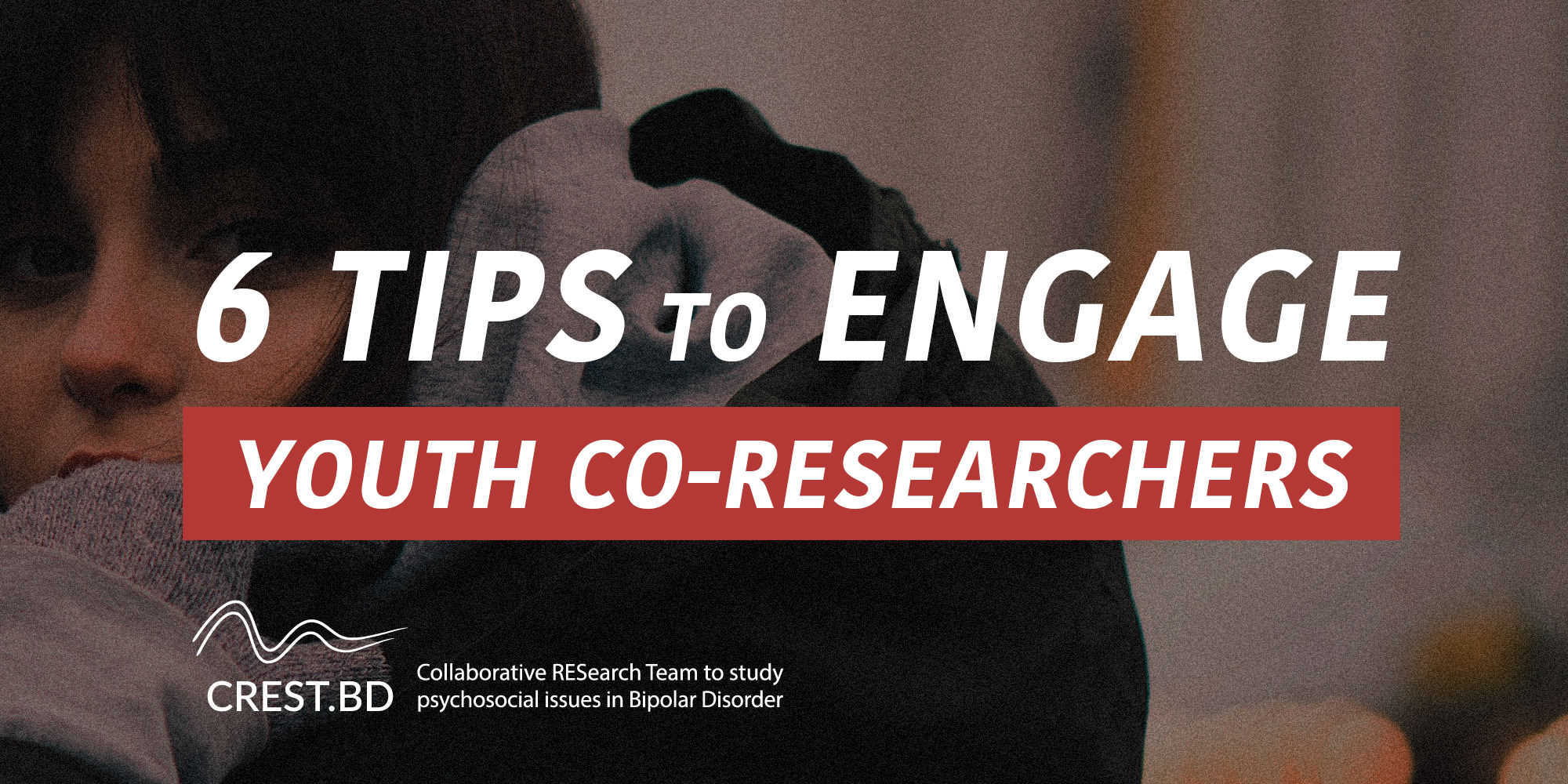Back in September, the Journal of Participatory Medicine released our paper about youth engagement on The Bipolar Youth Action Project (the BYAP). The BYAP ran from 2014-2015 in Victoria, BC, where we partnered with youth co-researchers with bipolar disorder. It was a Community-Based Participatory Research project that sought to find out (1) self-management strategies youth with bipolar disorder use to stay well, and (2) youth’s preferred means of knowledge translation for evidence-based mental health information.
In this blog post, we’ll share our top recommendations on engaging youth as co-researchers in participatory mental health research.
#1. Show youth co-researchers that you value their participation.
When peer researchers do not feel their participation is valued, they can feel discouraged from contributing and disengage.1,2 There are many ways to show that you value peer researcher participation, whether through direct compensation or through acknowledgement and respect for their contributions.
Compensation can be tangible, as with reimbursement for travel and childcare, providing meals, or monetary compensation.3 It can also take more abstract forms, such as demonstrating respect or publicly acknowledging co-researchers’ work (if that is something they would like).3 We highly recommend providing financial compensation for work, but also encourage giving peer researchers options for other forms of compensation. On the BYAP, some of these forms were co-authorship on academic papers and opportunities for further involvement. Free food always goes over well, too! To a young member of an at-risk population, food that others may take for granted might be beyond their usual price points. Providing meals is a good way to share your resources in a meaningful way.
Additionally, when peer researchers feel their input is not meaningful to plans or discussions, they may disengage.1 On the BYAP, we addressed this in several ways, including inviting youth co-researchers to write agendas (ensuring youth priorities would be directly woven in), assigning co-leads to independently plan with the other peer researchers and represent their points of view, and holding meetings in an environment of comfort and mutuality at local spaces with shared meals.
#2. Be flexible in meeting the needs of youth–in multiple domains.
Youth often juggle many obligations, such as school, jobs, volunteer positions, and familial responsibilities. Their hours of work might change from week to week, and can differ significantly from those of academic team members. When possible, adjusting your working hours to suit youth researchers can help them remain engaged. Doodle polls are a good tool for checking in advance when people will be available. The BYAP group often met on weekends or evenings.
Flexibility also means recognizing and accepting that youth priorities might differ from those of an academic team. On the BYAP, while the academic team prioritized longer-term research goals, youth co-researchers tended to prioritize immediate action and advocacy work. In cases like this, the goals proceed “in parallel:” they’re distinct, but still move in the same direction as the academic teams.4 It’s at the point of connection that you can move towards a mutual aim.
For youth with mental health conditions, it’s also important to be flexible in your expectations. Since bipolar disorder involves fluctuations in mood and energy, we knew there was a good chance that youth engagement would vary over the course of the project. We accepted that members might drop out because of mental health difficulties, and had a back-up plan in place to recruit more members if that happened, or to welcome them back if they wished.
#3. Agree on concrete responsibilities and deadlines.
Youth, who are often used to hierarchies in which they are told what to do, might need extra direction to feel confident taking action. In our work on the BYAP, we found that youth co-researchers were hesitant to take action when they felt expectations from the academic team weren’t clear. To adjust to the youth peer researchers’ need for structure, we developed a workflow that prioritized clear deliverables and mutually chosen deadlines. After collectively establishing these principles, youth peer researcher engagement and outputs increased.
If you’re working with youth researchers and finding they’re creating less work than expected, consider whether you’ve established a clear course of action together. Keep in mind that activities that might seem obvious to academic researchers could be unclear or unknown to youth co-researchers. Jointly establishing clear responsibilities and deadlines might help youth feel more engaged and confident in contributing.
#4. Prioritize effective communication.
As other works in participatory research have discussed, ineffective communication can lead to disengagement of peer researchers.2 Engagement and outputs can be increased by sending out meeting reminders about assigned work.5 On the BYAP, we noticed that when we sent out more email reminders and more clearly delineated tasks, the youth co-researchers were more engaged. We recommend maintaining frequent content with youth peer researchers, sending follow-ups, and encouraging them to email or message you when they have questions or concerns.
#5 When possible, opt for a longer timeline.
Authentic engagement takes time. As other commentators in participatory research have noted, running time-pressured projects can cause the involvement of peer researchers to become tokenistic or superficial.2,6 Youth in particular may feel less comfortable speaking their mind openly, or assuming responsibility without support, so longer timelines can help provide the space to build relationships and confidence. On the BYAP, we found that the youth members were more comfortable taking charge as the project went on. We also found that, even though some members did drop out in the early stages of the project, once we had formed relationships with youth, the same core group stayed on the project from start to end.
In order to support youth in becoming authentically engaged, we recommend conducting longer-term Community-Based Participatory Research projects when funding allows. If this isn’t an option, partnering with a community member with existing relationships to peer researchers might help to forge those crucial connections more easily.
#6. Recognize peer researchers may rely on your services, and consider the ethical implications of that.
Although those of us who work in participatory research want to ensure that peer researchers are engaged, we also want to make sure they are engaged for the right reasons. When a research or community organization is working with an at-risk, seldom heard population, it’s important to consider that they might rely on the services you provide. If this is the case, participants in your study might feel like they have to remain on the project, or behave in a certain way, so that they can maintain positive relationships with the people that provide essential health services to them.
With this in mind, we recommend reassuring peer researchers that your highest priority is to ensure that they are able to get the services they need. Make sure they know that they do not need to act in a certain way, or continue participating in the study, to maintain good relationships with the people who help them manage their mental health.
If you liked this post…
You may be interested in an upcoming post from Julia Gray, a youth research assistant at Foundry BC. In the post, she’ll share her story of working with 3 other youth research assistants on a project to bridge the “Digital Divide”. Stay tuned!
References
- Waite J, Poland F, Charlesworth G. Facilitators and barriers to co-research by people with dementia and academic researchers: Findings from a qualitative study. Health Expect 2019 Aug 22;22(4):761-771 [FREE Full text] [CrossRef] [Medline]
- Troya MI, Chew-Graham CA, Babatunde O, Bartlam B, Higginbottom A, Dikomitis L. Patient and Public Involvement and Engagement in a doctoral research project exploring self-harm in older adults. Health Expect 2019 Aug;22(4):617-631 [FREE Full text] [CrossRef] [Medline]
- Bastida EM, Tseng T, McKeever C, Jack L. Ethics and community-based participatory research: perspectives from the field. Health Promot Pract 2010 Jan;11(1):16-20 [FREE Full text] [CrossRef] [Medline]
- Lohmeyer BA. ‘Keen as fuck’: youth participation in qualitative research as ‘parallel projects’. Qualitative Research 2019 Jan 09;20(1):39-55. [CrossRef]
- Schlaudecker JD, Goodnow K, Goroncy A, Hartmann R, Regan S, Rich M, et al. Meaningful Partnerships: Stages of Development of a Patient and Family Advisory Council at a Family Medicine Residency Clinic. J Participat Med 2019 Mar 20;11(1):e12105. [CrossRef]
- Lincoln AK, Borg R, Delman J. Developing a community-based participatory research model to engage transition age youth using mental health service in research. Fam Community Health 2015;38(1):87-97 [FREE Full text] [CrossRef] [Medline]




Leave a Reply